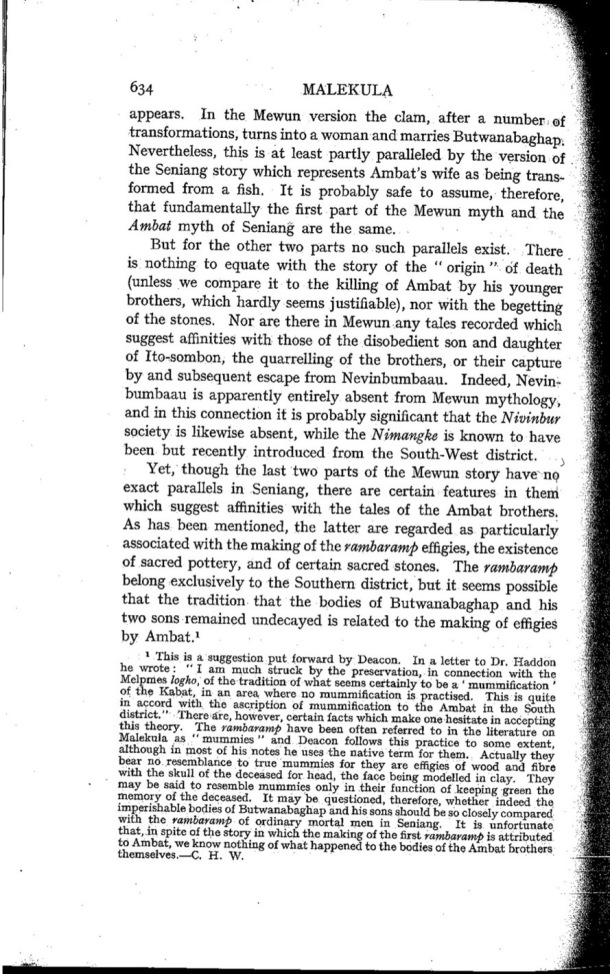|
|  [Note: tHis transcription was produced by an automatic OCR engine]
534 MALEKULA ‘
appears. In tHe Mewun version tHe clam, after a number of
transformations, turns into a woman and marries Butwa.nabagHap_
NevertHeless, tHis is at least partly paralleled by tHe version of
tHe Seniang story wHicH represents Ambat's wife as being trans-
formed from a ï¬ÅsH. It is probably safe to assume, tHerefore,
tHat fundamentally tHe first part of tHe Mewun mytH and tHe
Ambat mytH of Seniang are tHe same.
But for tHe otHer two parts no sucH parallels exist. THere
is notHing to equate witH tHe story of tHe “ originâ€ù of deatH
(unless we compare it to tHe killing of Arnbat by His younger
brotHers, wHicH Hardly seems justifiable), nor witH tHe begctting
of tHe stones. Nor are tHere in Mewun any tales recorded wHicH
suggest affinities witH tHose of tHe disobedient son and daugHter
of Ito-sombon, tHe quarrelling of tHe brotHers, or tHeir capture
by and subsequent escape from Ncvinbumbaau. Indeed, Nevin-
bumbaau is apparently entirely absent from Mewun mytHology,
and in tHis connection it is probably signiï¬Åcant tHat tHe Nivinbur
society is likewise absent, wHile tHe Nimangke is known to Have
been but recently introduced from tHe S0utH—West district. )
Yet, tHougH tHe last two parts of tHe Mewun story Have no
exact parallels in Scniaiig, tHere are certain features in tHem
wHicH suggest aflinities witH tHe tales of tHe Ambat brotHers.
As Has been mentioned, tHe latter are regarded as particularly
associated witH tHe making of tHe vambammp efï¬Ågies, tHe existence
of sacred pottcry, and of certain sacred stones. THe mmbaramp
belong exclusively to tHe SoutHern district, but it seems possible
tHat tHe tradition tHat tHe bodies of ButwanabagHap and His
two sons remained undeciiyed is related to tHe making of efï¬Ågies
by Ambat.‘
1 THis i! H. suggestion put. i0i'Wi-Id Hy Deacon. In ii letter to DI. nniiann
He Wflitei " i Mn mucH Slrlmk by tHe preservation, in connection witH tHe
Melgmes ram, oi tHe tradition 01 wHat scni.‘nS certainly to be 1 ‘ mllmmiï¬Åflutibfl '
Of t 6 Knbat, in .-in mi WHere no iniiinrnismiHn is Kructised. THis is qllltie
in accord witH tHe A5ci'iptlOn iii iniiininiiiiniiinn to t E Anibat in uni SoutH
dl.8LYlCt.“ THere arc, However, cértflin facts wHicH niiiiw one Hiiiicm in accepting
tHis tHeory. THe Vdmbninmfl Have been nmn relflilï¬Åd to in tHe literltulï¬Å nn
Malekllln 63 "mim!1‘lE '~ and Deacon fullcwl tHis practice to BOX!!!) extent,
altHougH in I505! of His notes He D588 tHe native min for tHem. Actually tHey
bear no raemblance to true mummies for tHey nie efligies of Wflbd and ï¬Åbre
witH tHe skull of tHe deceased mi Hefld, tHe me being modelled in Clay. THey
lllfly be said to resemble mummifl only in tHeir function of keeping K1650 tHe
memory oi tHe deteased. It may be questioned, tHefelbte, WHetHer il‘ldB€d tHe
irnperisHable bodies ni BfltwaflflbigHap and His Bulls sHflllld be so closely Cnmpared
witH tHe mmbnmmp oi Oidlllï¬Åfy inHiiii men in Seniang. It is iinmiiiinm
tHat, in spite ii; tHe flflry in wHicH tHe making of tHe ï¬Ål'5l mmbflmmp is attributed
to Ambat, we know notHing iiiwiiiie Happened to iii» bodies Hi tHe Ambit: brfltlwrs
tZH€lI1!BlV¢l.—C. i-i. w.
-s
|